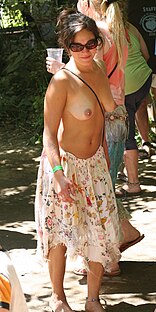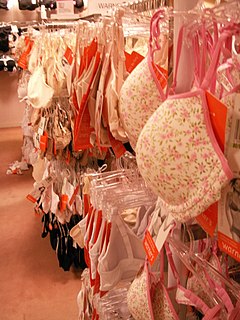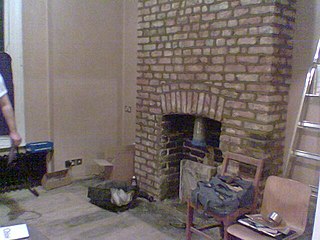
Breast cancer is cancer that develops from breast tissue. Signs of breast cancer may include a lump in the breast, a change in breast shape, dimpling of the skin, fluid coming from the nipple, a newly inverted nipple, or a red or scaly patch of skin. In those with distant spread of the disease, there may be bone pain, swollen lymph nodes, shortness of breath, or yellow skin.

The nipple is a raised region of tissue on the surface of the breast from which, in females, milk leaves the breast through the lactiferous ducts to feed an infant. The milk can flow through the nipple passively or it can be ejected by smooth muscle contractions that occur along the ductal system. The nipple is surrounded by the areola, which is often a darker color than the surrounding skin. It is often called a teat when referring to non-humans. Teat can also be used to describe the flexible mouthpiece of a baby bottle. In humans, nipples of both males and females can be stimulated as part of sexual arousal. In many cultures, human female nipples are sexualized, or "...regarded as sex objects and evaluated in terms of their physical characteristics and sexiness."

Metastasis is a pathogenic agent's spread from an initial or primary site to a different or secondary site within the host's body; it is typically spoken of as such spread by a cancerous tumor. The newly pathological sites, then, are metastases (mets). It is generally distinguished from cancer invasion, which is the direct extension and penetration by cancer cells into neighboring tissues.

Mammography is the process of using low-energy X-rays to examine the human breast for diagnosis and screening. The goal of mammography is the early detection of breast cancer, typically through detection of characteristic masses or microcalcifications.

Breast augmentation and augmentation mammoplasty are plastic surgery terms for the breast-implant and the fat-graft mammoplasty approaches used to increase the size, change the shape, and alter the texture of the breasts of a woman. As a primary reconstruction, augmentation mammoplasty is applied to effect a post–mastectomy breast reconstruction, the repair of the chest wound consequent to the removal of a cancerous breast; to correct congenital defects of the breast(s); and to correct congenital defects of the chest wall. As an elective, cosmetic surgery, primary augmentation changes the aesthetics – of size, shape, and texture – of healthy breasts.

Reduction mammoplasty is the plastic surgery procedure for reducing the size of large breasts. In a breast reduction surgery for re-establishing a functional bust that is proportionate to the woman's body, the critical corrective consideration is the tissue viability of the nipple-areola complex (NAC), to ensure the functional sensitivity and lactational capability of the breasts. The indications for breast reduction surgery are three-fold — physical, aesthetic, and psychological — the restoration of the bust, of the woman's self-image, and of her mental health.

A hematoma or haematoma is a localized bleeding outside of blood vessels, due to either disease or trauma including injury or surgery and may involve blood continuing to seep from broken capillaries. A hematoma is benign and is initially in liquid form spread among the tissues including in sacs between tissues where it may coagulate and solidify before blood is reabsorbed into blood vessels. An ecchymosis is a hematoma of the skin larger than 10mm.
As a paraphilia, breast fetishism is a highly atypical sexual interest focused on female breasts. The term breast fetishism is also used in the non-paraphilic sense, to refer to cultural attention to female breasts and the sexuality they represent, with debate existing as to whether the modern widespread fascination with breasts among heterosexual males in western societies is a sexual fetish.

Toplessness refers to the state in which a woman's torso is exposed above her waist or hips, or with at least her breasts, areola, and nipples being exposed, especially in a public place or in a visual medium. The male equivalent is barechestedness, also commonly called shirtlessness.

Tamoxifen, sold under the brand name Nolvadex among others, is a medication that is used to prevent breast cancer in women and treat breast cancer in women and men. It is also being studied for other types of cancer. It has been used for Albright syndrome. Tamoxifen is typically taken daily by mouth for five years for breast cancer.

Cleavage is the exposed area between a woman's breasts lying over the sternum, and refers only to what is visible with clothing that includes a low-cut neckline. In some cultures, display of cleavage is considered aesthetic or erotic, and may be associated with garments with low necklines that expose or highlight cleavage, such as ball gowns, evening gowns, lingerie, and swimwear. In these cultures women have, throughout history, sought to enhance their physical attractiveness and femininity, within the context of changing fashions and cultural-specific norms of modesty of the time and place. The methods practised in appropriate contexts have included the accentuation and partial display of breasts, including cleavage. In some cultures any display of cleavage may be culturally taboo illegal or otherwise socially disapproved.

In human anatomy, the internal thoracic artery (ITA), previously known as the internal mammary artery, is an artery that supplies the anterior chest wall and the breasts. It is a paired artery, with one running along each side of the sternum, to continue after its bifurcation as the superior epigastric and musculophrenic arteries.

A breast implant is a prosthesis used to change the size, shape, and contour of a person's breast. In reconstructive plastic surgery, breast implants can be placed to restore a natural looking breast mound for post–mastectomy breast reconstruction patients or to correct congenital defects and deformities of the chest wall. They are also used cosmetically to enhance or enlarge the appearance of the breast through breast augmentation surgery.
Mastopexy is the plastic surgery mammoplasty procedure for raising sagging breasts upon the chest of the woman, by changing and modifying the size, contour, and elevation of the breasts. In a breast-lift surgery to re-establish an aesthetically proportionate bust for the woman, the critical corrective consideration is the tissue viability of the nipple-areola complex (NAC), to ensure the functional sensitivity of the breasts for lactation and breast-feeding.

A bra, short for brassiere, is a form-fitting undergarment designed to support or cover the wearer's breasts. Bras are designed for a variety of purposes, including enhancing a woman's breast size, creating cleavage, or for other aesthetic, fashion or more practical considerations. Swimsuits, camisoles, and backless dresses may have built-in breast support. Nursing bras are designed to facilitate breast-feeding. Some women have a medical and surgical need for brassieres, but most women wear them for fashion or cultural reasons. There is no evidence that bras actually prevent breasts from sagging.

Breastfeeding, also known as nursing, is the feeding of babies and young children with milk from a woman's breast. Health professionals recommend that breastfeeding begin within the first hour of a baby's life and continue as often and as much as the baby wants. During the first few weeks of life babies may nurse roughly every two to three hours, and the duration of a feeding is usually ten to fifteen minutes on each breast. Older children feed less often. Mothers may pump milk so that it can be used later when breastfeeding is not possible. Breastfeeding has a number of benefits to both mother and baby, which infant formula lacks.

A chimney breast is a portion of a chimney which projects forward from a wall to accommodate a fireplace. Typically on the ground floor of a structure, the masonry extends upwards, containing a flue which carries smoke out of the building through a chimney stack. Chimney jambs similarly project from the wall, but they do so on either side of the fireplace and serve to support the chimney breast. The interior of a chimney breast is commonly filled with brickwork or concrete.

















